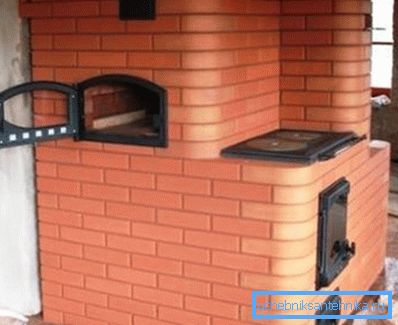Modern heating and cooking stoves: how good they are
Heating cooking stove, for several hundred years, does not lose its relevance. At the moment, the owners of a good half of private houses are trying to establish in themselves the construction of a similar plan. Of course, gas is wonderful, electricity is also good, but, unfortunately, not all places of our great country have these benefits of civilization stably. And in such conditions, a small heating stove will always help out.
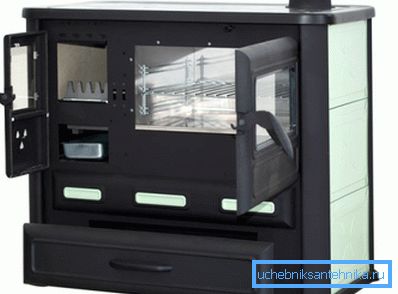
In the modern market there are many types of such equipment. For those whose rustic romance is not particularly impressive, ready-made cast-iron or steel structures for heating and cooking stoves are being produced.
But most of our compatriots prefer the classic brickwork. Each of these options is good in its own way, although about everything in order.
What does the market for finished products offer?
Far from all houses it is advisable to lay out a brick-built heater. Firstly, such laying requires arrangement of a capital foundation, and secondly, most of such furnaces have impressive dimensions and, let's say, are not suitable for a small dacha.
Under these conditions, compact and relatively inexpensive products made of cast iron or heat-resistant steel will be an excellent solution.
The market, these furnaces are great and in the framework of one article, it is impossible to describe it, so we will tell only about the most famous and high-quality models.
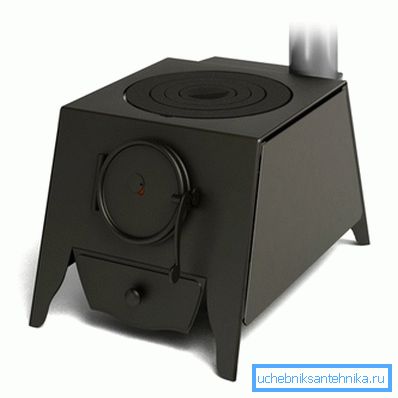
- Heating stove Alma Mons, is one of the recognized leaders among the structures of such a plan. It is a mixed type of frying-heating stoves, with a fireplace option. Although the casing itself and the frying surface are made of metal, the firebox itself is equipped with a refractory brick, which significantly prolongs the service life and localizes the main amount of heat near the frying surface.
- Breneran or an improved Canadian, united in itself all the advantages of the Canadians produced now, with the possibility of full cooking.
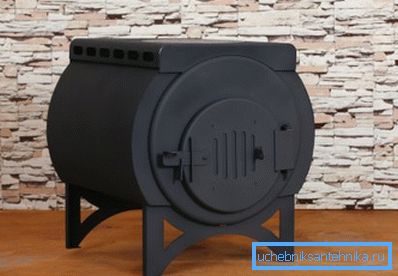
- Domestic manufacturers have pleased the release of a compact, portable furnace Taiga. Of course, it is not suitable for a large cottage, but it is quite suitable for a forest hut, a hunting lodge or a small cottage. In fact, it is a modern version of the stove. During the development, the main emphasis was placed on heating, the frying surface in it is small and will fit only for a kettle or a single frying pan.
- It is impossible not to recall the whole line of furnaces Bavaria. They are vertically oriented, capital structures of cast iron or thick heat-resistant steel. The furnace here is also laid out with fireclay bricks, which ensures reliable operation for several decades.
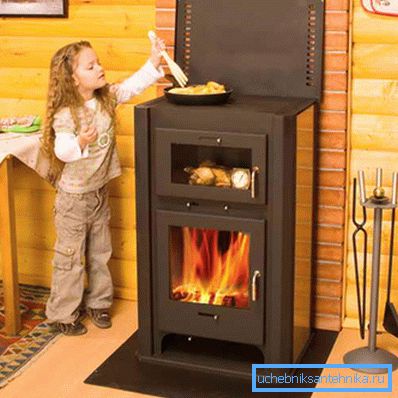
Brick construction
No matter how good metal products, but our people prefer capital brickwork more. Heating brick stoves are usually built from 2 types of blocks.
This is a traditional solid red brick, from which the furnace base and chimney is constructed. And refractory fireclay blocks, of which the furnace is directly laid out.
A distinctive feature of brick structures is the abundance of the proposed models. Schemes of heating cooking ovens can be varied and sometimes quite different from each other. Here you can find both small corner options and capital facilities capable of heating a two-story house.
Main nodes
- Firebox or firebox, is, in fact, the heart of the entire structure. The effectiveness of the roasting function of the oven depends on how efficiently and competently it will be. An error here will entail an excessive consumption of fuel, with low efficiency of the unit.
- Blown out, can be considered a constructive part of the furnace. This is a relatively small niche located directly under the fire. It is designed for natural air supply from below. The boundary between the furnace and the ash chamber is a grate made of cast iron grates. The intensity of burning fuel can be adjusted by opening or closing the door blew.
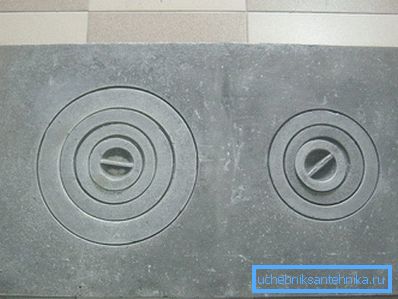
- A cooker is a metal, as a rule, cast-iron stove, on which the food itself is prepared. Sometimes it is equipped with one or two burners, removing which provides direct contact with the dishes with an open fire.
- The chimney is considered one of the main nodes. Actually most of the designs differ in the configuration of the chimney. It can be direct or have special channels that regulate cravings and the level of heat transfer.
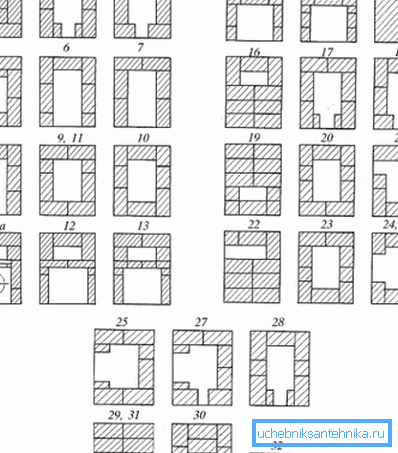
Important: the heating cooking stove with oven is not always met. Capital brick structures of medium and large sizes are equipped with such luxury as a baking chamber, but a simple heating and cooking oven, provides only for the presence of the frying surface and the function of heating the room.
What are good combined designs
- First of all, it is universality, in fact, we have two in one. If the owners of large cottages can afford to equip a boiler room and kitchen separately, then for small houses this is an urgent problem.
- Combined heating and cooking functions can significantly save on fuel. It is quite simple to build in such furnaces the registers through which the heat-transfer fluid will circulate. As a result, we get the simplest analogue of a solid fuel boiler, plus you can cook to eat.
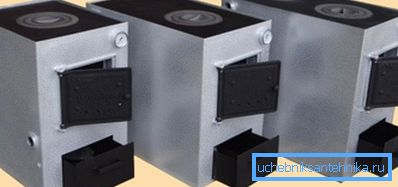
- With the right approach, even without having the fundamental knowledge, such a structure can be folded by hand. Instructions on how to fold the stove heating stove, on their own, well shown in the video below.
Types of brick ovens
As mentioned earlier, there are many models of such structures. Which of them to give their preference is decided purely individually. This is done depending on the size of the house and the requirements for this design.
Projects, precise drawings and stage-by-stage masonry of a heating cooking stove are easily found in the relevant literature. We just give the main characteristics of the models.
One of the places of honor in this row is occupied by a heating cooking stove of the IF Volkov design. In relatively small dimensions 110x90x244 cm, the designer was able to combine all the necessary functions. In addition to the hob, there is also an oven and a system of channels that provide heating.
A big plus is the presence of a water tank. For laying used red and fireclay bricks.
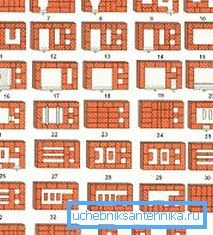
Important: this design provides for operation in winter and summer modes. In other words, working at full capacity, it heats and can be cooked on it. In the summer, when the heating is superfluous, the oven is transferred to an economical mode and is used only for cooking.
The main competition designs I.F. Volkov make furnace V.A. Potapova. There are two common options that differ not only in their dimensions, but also in their characteristics.
The small version, having dimensions of 51x64x182 cm, is capable of producing no more than 1500 kcal for one hour, it is more suitable for summer cottages or a hunting lodge.
An advanced, large version, already has dimensions of 116x64x190 cm and is capable of producing up to 4000kcal per hour. It is suitable for almost any home of medium size, both in the country version, and for continuous operation. But, despite the obvious differences in characteristics, both of these models are equipped with a frying surface, an oven and a tank for heating water.
Tip: Volkov and Potapov’s furnaces are unquestionably the most popular, but fortunately they are not the only ones. We advise you to look also at the projects of Zhirnova, Sterzhnev or Kuznetsov.
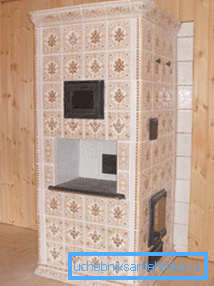
Settlement Tips
Since we are going to cook on the stove, the firebox itself should be of suitable size. In particular, it is recommended to make a tunnel of at least three and a half bricks in length. This will allow to load logs up to 60 cm into the firebox.
Important: chamotte brick is a good thing. But it is recommended to lay out only the lining of the furnace itself. If you decide to completely fold the entire structure of this refractory material, then due to the difference in linear expansion, the structure will soon crack and become unusable.
The frying surface itself should be at a convenient height, it is about 90 cm. If we count by the rows of bricks, we get 12 or 13 rows. This height has been tested experimentally and is the most convenient, by the way, gas and electric ovens are made exactly of this height.
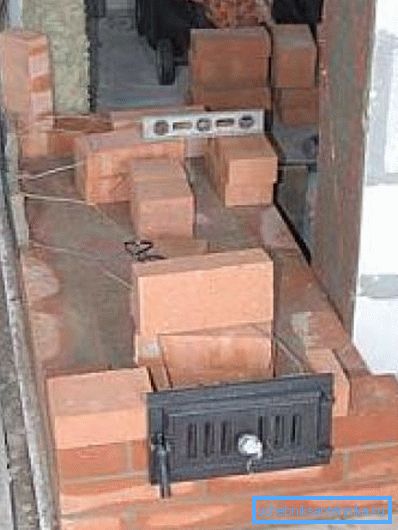
It is important to choose the optimal height of the niche itself, in other words, the distance from the oven, to the roof. Experts recommend varying between 6 and 8 rows of bricks. If you do less, then it will be inconvenient to cook, but if on the contrary it is too much to lift the arch, there will be no place for arranging the drying cabinet.
Built-in oven is quite a powerful source of heat. And if in winter it can be considered a virtue, then in the summer it will greatly hinder.
Alternatively, you can install heat-insulated doors made of heat-resistant glass on the oven. The price of them is certainly not small, but you will not get burned about them and will be able to control the pastries.
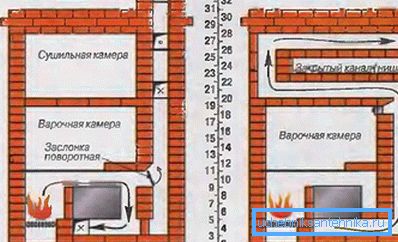
The video shows the details of the arrangement of the furnaces.
Conclusion
Of course, there are simple heating heating projects that are quite realistic to lay out with your own hands. But it’s worth trying your strength at the cottage or in another similar place. If you plan to heat a cooking stove in a residential private house for permanent use, it is better to hire a professional, because if you make a mistake, you will remember your spouse more than once (see also the article Order heating-cooking stoves: tips on choosing and implementing a project).
